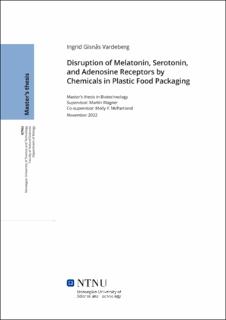| dc.description.abstract | Plast er et allsidig materiale med fordelaktige egenskaper, som holdbarhet, lav vekt og lave priser. Dette gjør materialet egnet for et bredt spekter av forbrukerprodukter. Plast er av stor samfunnsmessig interesse, blant annet fordi materialet er avgjørende for matkonservering. Menneskelig eksponering for plastkjemikalier fra produkter som er i kontakt med mat er imidlertid bekymringsfull ettersom plastkjemikalier kan migrere fra emballasje til mat. Mange av stoffene i plast er ukjente og det er derfor ikke mulig å vite virkninger av disse. Helseeffekten av plastkjemikalier er følgelig bekymringsverdig. Siden det meste av forskning på reseptorsignalforstyrrende plastkjemikalier har blitt utført på cellekjernereseptorer, etterstreber denne studien å gi ny innsikt i plastkjemikalieforstyrrelse av G-proteinkoblede reseptorer.
Denne studien undersøker hvorvidt agonister for G-proteinkoblede reseptorer er til stede i plastprodukter laget av fem polymertyper (polyetylen, polypropylen, polystyren, polyuretan og polyvinylklorid). Dette gjøres ved å kombinere cytotoksisitetstesting, PRESTO-Tango- analyser og kjemisk analyse av reseptor-aktiverende plastekstrakter. Vi studerte fem G- proteinkoblede reseptorer av terapeutisk betydning, inkludert to melatonin-reseptorer (MTNR1A og MTNR1B), to serotonin-reseptorer (HTR1A og HTR2C) og én adenosin- reseptor (ADORA1). For å undersøke plastkjemikalieeffekten på disse reseptorene, ekstraherte vi kjemikalier fra plastprodukter brukt til matoppbevaring. Deretter utførte vi cytotoksisitetsforsøk for å sikre at toksiske konsentrasjoner av plastekstraktene ikke ble brukt i PRESTO-Tango-analysene. Så utførte vi PRESTO-Tango-analyser for å identifisere individuelle plastprøver som inneholdt agonister for G-proteinkoblede reseptorer. Til slutt brukte vi data fra non-target-analyser av de aktiverende plastekstraktene for å redusere antall agonistkandidater.
Vi konkluderer med at polyuretan er den mest cytotoksiske plastprøven, og videre at en blandingseffekt av polyvinylklorid-prøvene er tydelig. Fungerende PRESTO-Tango-analyser ble bekreftet med referanseforbindelser for fire av fem G-proteinkoblede reseptorer undersøkt i denne studien (MTNR1A, MTNR1B, HTR1A og ADORA1). Kjemikaliene i to polyvinylklorid-prøver aktiverte MTNR1A, mens én polyuretan- og én polyvinylklorid-prøve aktiverte ADORA1. Listen over mulige agonister fra de aktiverende plastekstraktene ble betraktelig redusert. Alt tatt i betraktning viser denne studien at plastprodukter i kontakt med mat inneholder mange potensielle agonister for G-proteinkoblede reseptorer.
Resultatene av denne studien understreker viktigheten av videre forskning på plastkjemikaliers faktiske innvirkning på menneskers helse. Effekten av polymerblandinger og ikke-tilsiktede substanser i plast bør undersøkes videre. I tillegg bør internasjonale reguleringer og åpenhet rundt plastproduksjon adresseres for å etablere produkter som ikke utgjør risiko for menneskehelse. | |
| dc.description.abstract | Plastics are versatile materials with beneficial properties such as durability, light weight, and low price, making them suitable for a wide range of consumer products. Plastics have great societal benefits, for instance when used as food contact materials for preserving foodstuff. However, human exposure to plastic chemicals is of concern as several plastic chemicals have negative health impacts and further, as the chemicals can migrate from the packaging into the foodstuff. Since many of the substances in plastics are truly unknown, possible impacts of exposure cannot be addressed. Thus, the human health effect of plastic chemicals is of concern. Since most research on receptor signal disruption by plastic chemicals have been conducted on nuclear receptors, this study sought to provide novel insight to plastic chemical disruption of G protein-coupled receptors.
By combining cytotoxicity testing, PRESTO-Tango assays, and chemical analysis of receptor activating plastic samples, this study investigated whether agonists for G protein-coupled receptors are present in food contact articles made of five polymer types (polyethylene, polypropylene, polystyrene, polyurethane, and polyvinyl chloride). We studied five G protein- coupled receptors of therapeutical importance, including the melatonin receptors MTNR1A and MTNR1B, serotonin receptors HTR1A and HTR2C, and the adenosine receptor ADORA1. We extracted plastic chemicals from food contact articles, and then performed cytotoxicity experiments to ensure non-cytotoxic plastic exposure in the PRESTO-Tango assay. We then conducted PRESTO-Tango assays to identify individual plastic samples that contained G protein-coupled receptor agonists. Lastly, we used data from non-target chemical analysis on the activating plastic samples to narrow down the list of agonist candidates.
We concluded that polyurethane was the most cytotoxic sample, and further, that a mixture effect of the polyvinyl chloride mix was apparent. We confirmed PRESTO-Tango assays for four of the five receptors studied in this thesis (MTNR1A, MTNR1B, HTR1A, and ADORA1) by reference compounds. The chemicals present in two polyvinyl chloride samples activated MTNR1A while one polyurethane and one polyvinyl chloride sample activated ADORA1. For the active plastic samples, we greatly reduced the list of possible agonists obtained from non- target chemical analysis, and all combined, this study shows that food contact articles contain numerous potential G protein-coupled receptor agonists.
The results of this study emphasizes the importance of further research on food contact chemicals’ realistic impact on human health. Challenges of mixture effects and non- intentionally added substances of plastics should be addressed, and moreover, international regulations and transparency regarding plastic production is called for to approach plastic products that do not pose a risk to human health. | |
